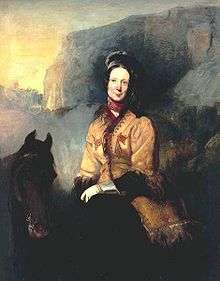Florentia Sale
Florentia Sale (née Wynch; 13 August 1790 – 6 July 1853)[1] was an Englishwoman who travelled the world while married to her husband, Sir Robert Henry Sale, a British army officer. She was dubbed "the Grenadier in Petticoats"[2] for her travels with the army, which took her to regions such as Mauritius, Burma and India, and various other areas under the control of the British Empire.
Florentia Sale | |
|---|---|
 Sale by Richard Thomas Bott, 1844 | |
| Born | Florentia Wynch 13 August 1790 |
| Died | 6 July 1853 Cape Town, South Africa |
| Nationality | English |
Notable work | A Journal of the Disasters in Afghanistan, 1841–2 |
| Spouse(s) | Sir Robert Henry Sale (1809–1845) |
Early life
Florentia Wynch was born on 13 August 1790, in Madras, during Company rule in India, the daughter of George Wynch, a member of the civil service.[3] George's father Alexander Wynch was the Governor of Madras for a time during the 1770s.[3] It is possible she is named after her paternal grandmother, Florentia Craddock, wife of Alexander.[4] She was raised by her uncles and received a good education as a child.[5]
Marriage and adult life
In 1809, Wynch married Sir Robert Henry Sale of the British Army. She accompanied him on his numerous postings, raising their children while he fought. The couple's first child, daughter Mary Harriet, was born a year after their marriage, on 17 February 1810 in Walajabad.[1] By the time of the birth of her second child, she had moved to Mauritius, where Sale was stationed; George Henry was born in 1811 in Port Louis, Mauritius.[1] Five of the couple's other children were born in Port Louis too, the last being in 1818.[1] On 1 October 1820, she bore her eighth child, Henrietta Sarah, in Montluel, France.[1] Her last child, Alexandrina was born nearly three years later, on 2 January 1823 in Calcutta, India.[1] All her children married into families with associations with India including Bruere, Bray, Holmes, Dysart, Hill and Brind.
During the First Anglo-Afghan War, Lady Sale, along with other women and children, as well as soldiers, were taken prisoner in 1842 during the British Army retreat from Kabul and detained for nine months.[6] The group were taken hostage by Akbar Khan following the massacre in the Khurd Karbul Pass. Amongst the hostages with Lady Sale was her youngest daughter Alexandrina, along with her husband Lieutenant John Sturt.[7] Sturt was fatally injured by a severe wound to his abdomen, in an attack in which Lady Sale was shot in the wrist and Mrs Sturt's pony was shot in the neck and ear. The two women nursed him his final hours.[8] Upon his death, she secured him a Christian burial. After nine months, the party managed to negotiate the Afghan captors into releasing them; they were then rescued by Sir Richmond Shakespear on 17 September 1842.[9] Throughout her time as a captive, Lady Sale kept a diary, detailing the events of the ordeal in a very straight forward and thoughtful manner. She sent parts of her diary through her captivity to her husband and he sent it on to the authorities in England and it was quoted by the papers at the time. She was unimpressed by how the newspapers had reported her actions. A year later, she published this as A Journal of the Disasters in Afghanistan, 1841–42, which documented her experiences throughout the Afghan War,[10] and the book received critical acclaim.
Lady Sale's husband died in action in 1845, leaving her widowed. From 1846-1848 she had a grace and favour apartment at Hampton Court Palace, just outside London.[7] She remained in India for most of the rest of her life.[11] After her husband's death she received a pension of £500 per annum in light of her conduct as a prisoner and her husband's military services.[7] Sale took a trip to the Cape of Good Hope in 1853 for her health,[7] though she died not long after her arrival, on 6 July 1853, in Cape Town,[11] South Africa. Her tombstone reads "underneath this stone reposes all that could die of Lady Sale".[12]
References
- "Florentia Wynch". Family Tree Maker. Retrieved 14 September 2011.
- Hugh Williams (2008), Fifty Things You Need to Know About British History, HarperCollins, pp. 302–303, ISBN 978-0-00-727841-1
- "India during the Raj". Adam Matthew Publications. Retrieved 15 September 2011.
- "Gifford Lodge: Twickenham". The Twickenham Museum. Retrieved 15 September 2011.
- Bijan Omrani. "Will we make it to Jalalabad?". Retrieved 15 September 2011.
- "British Empire primary sources: Diary, Lady Florentia Sale". Women in World History. Retrieved 16 July 2010.
- "Lady Sale" (PDF). Archived from the original (PDF) on 20 March 2012. Retrieved 15 September 2011.
- Sale, Florentia Wynch (2009). Lady Sale's Afghanistan : an indomitable Victorian lady's account of the retreat from Kabul during the First Afghan War. Leonaur/Oakpast Ltd. ISBN 9781846777325. OCLC 547500668.
- Adam Matthew. "India during the Raj". Adam Matthew Publications. Archived from the original on 6 October 2008. Retrieved 16 July 2010.
- Sale, Florentia (1843) A Journal of the Disasters in Affghanistan, 1841–42. Baudry's European Library, Paris.
- Adam Matthew. "Lady Florentia Sale on retreat from Kabul". Online Galleries. Retrieved 16 July 2010.
- Dalrymple, William (2013). Return of a King; the Battle for Afghanistan. London: Bloomsbury. ISBN 978 1 4088 1830 5. OCLC 955470310.
External links
- Will we make it to Jalalabad? Biographical article on Lady Sale by Bijan Omrani.